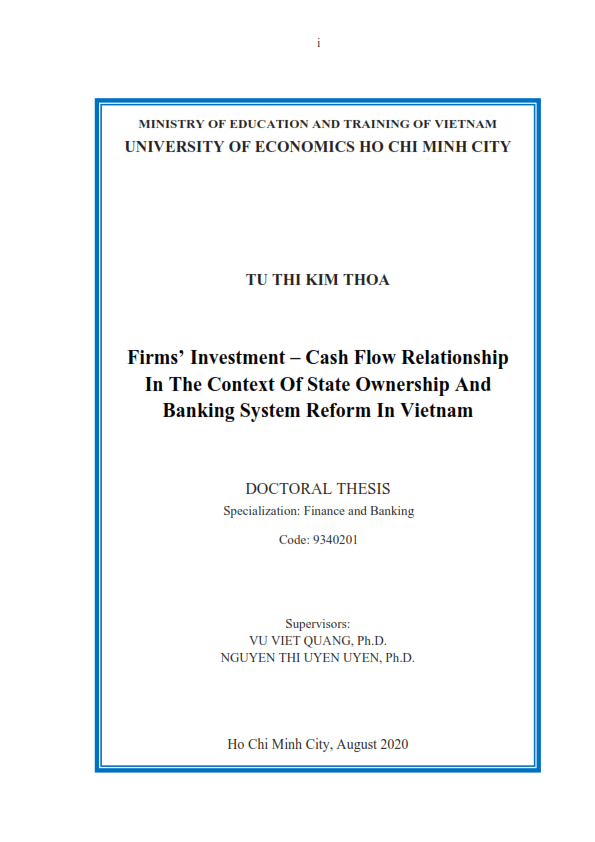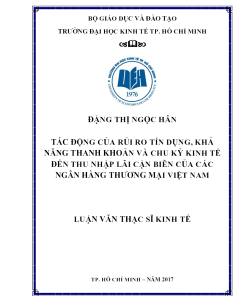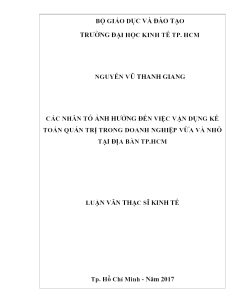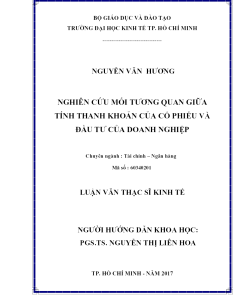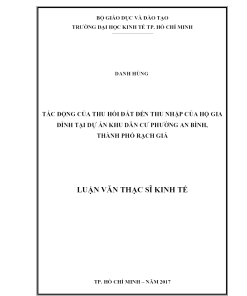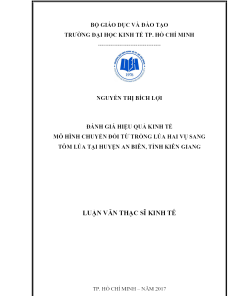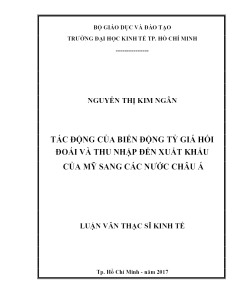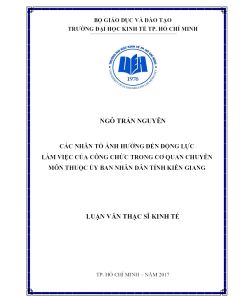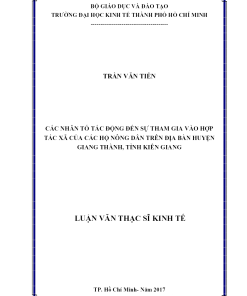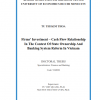- Giảm 10% phí tải tài liệu khi like và share website
- Tặng 1 bộ slide thuyết trình khi tải tài liệu
- Giảm 5% dịch vụ viết thuê luận văn thạc sĩ của Luận Văn A-Z
- Giảm 2% dịch vụ viết thuê luận án tiến sĩ của Luận Văn A-Z
Firms’ investment – cash flow relationship in the context of State ownership and banking system reform in Vietnam
50.000 VNĐ
Download Doctoral Thesis: Firms’ investment – cash flow relationship in the context of State ownership and banking system reform in Vietnam
Download Doctoral Thesis: Firms’ investment – cash flow relationship in the context of State ownership and banking system reform in Vietnam
This thesis applies the style of a series of papers in the field of corporate finance, which mainly composes of the two stand-alone essays. The first essay investigates the effect of state ownership on the relationship between investment and cash flow in Vietnam, a small transitional economy. Using a sample of companies listed on the both Ho Chi Minh City Stock Exchanges (HOSE) and Hanoi Stock Exchange (HNX) during the period 2008 to 2015, the U- shaped investment–cash flow relations for both state-owned and non-state-owned firms are found.
In addition, state-owned companies (SOEs) have higher cash flow sensitivity of investment, which perhaps is due to their socioeconomic and political responsibilities, poor corporate governance and agency problem. Their growth opportunities also affect the sensitivity. The second essay examines the effect of banking system reform, which is defined by the presence of foreign banks, on investment-cash flow relation in a context of a small transition economy.
I find evidence that the presence of foreign banks in Vietnam results in decreasing in firm’s dependence on local banks and has changed their financial constraint. Company investments are less reliant on internal cash flow in the post reform period.
Although overinvestment of state controlled firms cannot be reduced but underinvestment problem of non- state -controlled listed firms is mitigated due to better accessibility to bank loans. The investigated relation between investment and leverage is robust for this conclusion.
Keywords: Investments, Cash flow, Corporate finance, Government ownership, Ownership structure, Banking
First and foremost, I would like to express deepest gratitude to my supervisors, Dr. Vu Viet Quang and Dr. Nguyen Thi Uyen Uyen, for their continual guidance and mentorship, invaluable support, remarkable patience, useful feedback, and spiritual encouragement during the completion of my thesis. My thesis cannot be completed without their supervisions, which provided me with much precious advice to expedite my thesis completion.
I would like to thank the University of Economics Ho Chi Minh City for its generous financial support of my PhD studies. I also wish to thank all the colleagues at the UEH School of Finance, School of UEH Graduates and others for their great and continuing encouragement and full support during my PhD candidature.
My gratitude also goes to my colleagues at UEH who have constantly given a great help, support and encouragements to me not only during but also before the completion of my thesis.
Finally and most importantly, I would like to thank my friends and family for their unconditional love, immense, constant and endless support and encouragements during my life. I would have been unable to finish the thesis without their supports and encouragement. And I also wish to dedicate this thesis to my late mother who is always in my heart.
TABLE OF CONTENTS
ABBREVIATIONS……………………………………………………………………………….. i LIST OF TABLES ……………………………………………………………………………….. ii LIST OF FIGURES………………………………………………………………………………. v ABSTRACT ……………………………………………………………………………………….. vi CHAPTER 1: INTRODUCTION …………………………………………………………… 1
1.1. Thesis motivations ……………………………………………………………………………….1
1.2. Thesis objectives………………………………………………………………………………….5
1.3. Firm’s investment – cash flow relationship in the context of state ownership in Vietnam …………………………………………………………………………………………………….5
1.3.1. Objectives and hypotheses ……………………………………………………………5
1.3.2. Data …………………………………………………………………………………………..6
1.3.3. Methodology……………………………………………………………………………….6
1.3.4. Empirical findings ……………………………………………………………………….7
1.3.5. Contributions………………………………………………………………………………7
1.4. Firm’s investment – cash flow relation in the context of banking system reform in Vietnam …………………………………………………………………………………………………….8
1.4.1. Objectives and hypotheses ……………………………………………………………8
1.4.2. Data …………………………………………………………………………………………..9
1.4.3. Methodology……………………………………………………………………………….9
1.4.5. Contributions…………………………………………………………………………….10
1.5. Thesis structure ………………………………………………………………………………….10
CHAPTER 2: OVERVIEW ON VIETNAM’S ECONOMIC REFORMS…. 11
2.1. Overview on Vietnam’s economy ………………………………………………………..12
2.2. Overview on equitization of state owned enterprises of Vietnam……………..15
2.3. Overview on Vietnam’s banking system reform …………………………………….20
2.4. Chapter summary……………………………………………………………………………….25
ii
CHAPTER 3: FINANCIAL CONSTRAINTS AND INVESTMENT: A THEORETICAL FRAMEWORK AND LITERATURE REVIEW ………….. 27
3.1. Theories of investment ……………………………………………………………………….29
3.1.1. The Modigliani-Miller Theorem (MM) …………………………………………30
3.1.2. Neo-classical model …………………………………………………………………..30
3.1.3. Sales accelerator model ……………………………………………………………..31
3.1.4. Tobin’s Q model ………………………………………………………………………..32
3.1.5. The Euler model ………………………………………………………………………..34
3.2. Financial constraints and investment: a literature review ………………………..35
3.2.1. Financial constraint and investment …………………………………………….35
3.2.2. State Ownership and Investment–Cash Flow Relations ………………….44
3.2.3. Banking system reform and investment – cash flow relation……………46
3.2.4. Financial leverage, growth opportunity and investment relation……..48
3.3. Chapter summary……………………………………………………………………………….49
CHAPTER 4: FIRM’S INVESTMENT – CASH FLOW RELATIONSHIP IN THE CONTEXT OF STATE OWNERSHIP IN VIETNAM …………………… 51
4.1. The study introduction ………………………………………………………………………..52
4.2. Literature review and hypothesis development ………………………………………54
4.2.1. Relation between investment and cash flow…………………………………..54
4.2.2. State Ownership and Investment–Cash Flow Relations ………………….57
4.2.3. State Ownership and Investment–Leverage Relation ……………………..59
4.3. Research design …………………………………………………………………………………60
4.3.1. Testing Investment–Cash Flow Relation……………………………………….60
4.3.2. Testing the Impact of State Ownership on Investment–Cash Flow
Relations……………………………………………………………………………………………………..63
4.3.3. Testing the Impact of State Ownership on Investment–Leverage
Relations……………………………………………………………………………………………………..64
4.3.4. Data …………………………………………………………………………………………64
4.4. Empirical results ………………………………………………………………………………..65
iii
4.4.1. Descriptive Statistics ………………………………………………………………….65
4.4.2. Empirical Results ………………………………………………………………………67
4.4.3. Robustness Check………………………………………………………………………80
4.5. Conclusion ………………………………………………………………………………………..90
4.6. Chapter summary……………………………………………………………………………….91
CHAPTER 5: FIRM’S INVESTMENT – CASH FLOW RELATIONSHIP UNDER THE CONTEXT OF BANKING SYSTEM REFORM IN
VIETNAM ………………………………………………………………………………………… 92
5.1. The Stuty Introduction ………………………………………………………………………..93
5.2. Literature review………………………………………………………………………………..96
5.2.1. Investment – cash flow relation……………………………………………………96
5.2.2. Effect of banking system reform on investment – cash flow relation…98
5.3. Research methodology………………………………………………………………………..99
5.3.1. Hypothesis development and model specification ………………………….99
5.3.2. Data ……………………………………………………………………………………….104
5.4. Empirical results ………………………………………………………………………………105
5.4.1. Descriptive statistic ………………………………………………………………….105
5.4.2. Correlations ……………………………………………………………………………107
5.4.3. Regression results ……………………………………………………………………109
5.4.4. Robustness check……………………………………………………………………..127
5.5. Study conclusion………………………………………………………………………………128
5.6. Chapter summary……………………………………………………………………………..129
CHAPTER 6: CONCLUSION……………………………………………………………. 131
6.1. Introduction……………………………………………………………………………………..131
6.2. Firm’s investment – cash flow relationship in the context of state ownership in Vietnam …………………………………………………………………………………………………131
6.2.1. Research findings …………………………………………………………………….131
6.2.2. Research contributions, implications and policy recommendations .132
6.2.3. Research limitations and future research directions …………………….134
iv
6.3. Firm’s investment – cash flow relationship in the context of banking system reform in Vietnam ………………………………………………………………………………………135
6.3.1. Research findings …………………………………………………………………….135
6.3.2. Research contributions , implications and policy recommendations 136
6.3.3. Research limitations and future research directions …………………….138
LIST OF AUTHOR’S PUBLICATIONS …………………………………………….. 140
REFERENCES…………………………………………………………………………………. 141
APPENDIX ……………………………………………………………………………………… 147
i
ABBREVIATIONS
Agribank Vietnam Bank for Agriculture and Rural Development
ASEAN Association of Southeast Asian Nations
ATFA ASEAN Free Trade Agreement
BIDV Bank for Investment and Development of Vietnam
CPI Consumer Price Index FDI Foreign direct investment GDP Gross Domestic Products HCMC Ho Chi Minh City
HNX Hanoi Stock Exchange
HOSE Ho Chi Minh City Stock Exchange
JSCB Joint-stock commercial bank
JVB Joint – venture bank
MM Modigliani and Miller Theorem
SBV State Bank of Vietnam
SOCB State-owned commercial bank
SOE State owned enterprise
US United States of America
VCB Bank for Foreign Trade of Vietnam Vietinbank Vietnam Industrial and Commercial Banks WTO World Trade Organization
ii
Download Doctoral Thesis: Firms’ investment – cash flow relationship in the context of State ownership and banking system reform in Vietnam
LIST OF TABLES
Table 2.1 Stages of SOE equitization in Vietnam (1992 – 2018) 17
Table 2.2 Credit institutions of Vietnam, 2010 – 2017 22
Table 2.3 List of foreign banks’ branches in Vietnam 23
Table 3.1 Summary of Financial Constraint Proxies 43
Table 4.1 Sample structure 65
Table 4.2 Variable descriptive statistic 66
Table 4.3 Differences between non state-owned and state-owned 67
enterprises
Table 4.4 Analysis of relation between investment and cash flow 70
Table 4.5 Impact of state ownership on investment – cash flow 73
relation
Table 4.6 Impact of state ownership on relation between investment 75
and cash flow under different growth opportunities
Table 4.7 Impact of state ownership on the investment and leverage 78
relations
Table 4.8 Impact of state ownership on the relations between 79 investment – leverage under different growth opportunities
iii
Download Doctoral Thesis: Firms’ investment – cash flow relationship in the context of State ownership and banking system reform in Vietnam
Table 4.9 State ownership and relations between investment and cash 82 flow under different growth opportunities: GMM
estimation method
Table 4.10 Classification of state-owned and non-state-owned 85
enterprises using the threshold of 33.15 percent
Table 4.11 State ownership and relations between investment and cash 88 flow under different growth opportunities in which high
growth opportunity is classified by quartile
Table 5.1 Sample structure 105
Table 5.2 Variable descriptive statistic 106
Table 5.3 Pearson and Spearman correlation matrix 108
Table 5.4 Analysis of investment – cash flow relation 113
Table 5.5 Effect of banking system reform on investment – cash flow
relation
117
Table 5.6 Effect of banking system reform on investment –cash flow relation of state – controlled listed companies by different
growth opportunities.
120
Table 5.7 Effect of banking system reform on investment –cash flow relation of non state – controlled companies by different growth opportunities
122
iv
Download Doctoral Thesis: Firms’ investment – cash flow relationship in the context of State ownership and banking system reform in Vietnam
Table 5.8 Effect of banking system reform on investment – leverage
relation
124
Table 5.9 Effect of banking system reform on investment – leverage
relation for both low and high growth opportunities
126
Table 5.10 GMM estimates of investment – cash flow sensitivity 127
v
LIST OF FIGURES
Figure 2.1 Annual GDP growth rate for the period of 1986 – 2018 (%) 13
Figure 2.2 Vietnam’s Inflation (% change of CPI), 1986-2018 15
Figure 2.3 Progress of SOE equitization, 1992 – 2018 17
Figure 2.4 Number of SOEs, 1995 – 2017 19
Figure 5.1 Fitted value of investment (IK) on cash flow (CFK) on a full sample of Vietnamese listed firms for the period of
2009 – 2014
110
Figure 5.2 Fitted value of investment (IK) on cash flow (CFK) on a subsample of Vietnamese State controlled firms for the
period of 2009 – 2014
111
Figure 5.3 Fitted value of investment (IK) on cash flow (CFK) on a subsample of Vietnamese Non – state controlled firms for the period of 2009 – 2014
112
vi
ABSTRACT
This thesis applies the style of a series of papers in the field of corporate finance, which mainly composes of the two stand-alone essays.
The first essay investigates the effect of state ownership on the relationship between investment and cash flow in Vietnam, a small transitional economy. Using a sample of companies listed on the both Ho Chi Minh City Stock Exchanges (HOSE) and Hanoi Stock Exchange (HNX) during the period 2008 to 2015, the U- shaped investment–cash flow relations for both state-owned and non-state-owned firms are found. In addition, state-owned companies (SOEs) have higher cash flow sensitivity of investment, which perhaps is due to their socioeconomic and political responsibilities, poor corporate governance and agency problem. Their growth opportunities also affect the sensitivity.
The second essay examines the effect of banking system reform, which is defined by the presence of foreign banks, on investment-cash flow relation in a context of a small transition economy. I find evidence that the presence of foreign banks in Vietnam results in decreasing in firm’s dependence on local banks and has changed their financial constraint. Company investments are less reliant on internal cash flow in the post reform period. Although overinvestment of state controlled firms cannot be reduced but underinvestment problem of non- state -controlled listed firms is mitigated due to better accessibility to bank loans. The investigated relation between investment and leverage is robust for this conclusion.
JEL classification: G30, G31, G32
Keywords: financial constraints, investment – cash flow relations, state ownership, banking system reform, small transition economy.
vii
Download Doctoral Thesis: Firms’ investment – cash flow relationship in the context of State ownership and banking system reform in Vietnam
TÓM TẮT
Download Doctoral Thesis: Firms’ investment – cash flow relationship in the context of State ownership and banking system reform in Vietnam
Luận án này nhằm tìm hiểu ảnh hưởng của sở hữu nhà nước và cải cách hệ thống ngân hàng lên mối quan hệ giữa đầu tư và dòng tiền ở Việt nam – một nền kinh tế chuyển đổi nhỏ. Sử dụng mẫu các doanh nghiệp phi tài chính niêm yết trên các thị trường chứng khoán Việt nam trong giai đoạn 2008 – 2015, trước hết tác giả đã tìm thấy bằng chứng về về mối quan hệ chữ U giữa đầu tư và dòng tiền ở Việt nam. Ngoài ra, các doanh nghiệp nhà nước (SOEs) có độ nhạy cảm của đầu tư với dòng tiền cao hơn so với các doanh nghiệp tư nhân có lẽ bởi các trách nhiệm chính trị, kinh tế xã hội mà họ phải đảm nhiệm, cũng như cơ chế quản trị doanh nghiệp yếu kém và vấn đề đại diện ở những doanh nghiệp này.
Thứ hai, tác giả tìm thấy bằng chứng rằng sự hiện diện của các ngân hàng nước ngoài, là biến đại điện cho cải cách hệ thống ngân hàng, đã làm giảm sự phụ thuộc vào các ngân hàng nội địa của doanh nghiệp cũng như làm thay đổi tình trạng hạn chế tài chính của họ. Sau cải cách ngân hàng, đầu tư của doanh nghiệp ít phụ thuộc vào dòng tiền nội bộ hơn. Mặc dù tình trạng đầu tư quá mức của các doanh nghiệp nhà nước kiểm soát không giảm, nhưng vấn đề đầu tư dưới mức của các doanh nghiệp nhà nước không kiểm soát đã được giảm do gia tăng khả năng tiếp cận nguồn vốn từ bên ngoài. Luận án cũng tìm thấy bằng chứng củng cố kết luận này thông qua tìm hiểu mối quan hệ giữ đầu tư và tài trợ.
1
CHAPTER 1
INTRODUCTION
This thesis applies the style of a series of papers in the field of corporate finance, which mainly composes of the two stand-alone essays. This chapter summarizes the content of the thesis, which briefly presents the thesis’ motivations, objectives, methodologies, contributions and structure. Section 1.1 presents the thesis motivations on impact of financial constraints, particularly state ownership and banking system reform on firm’s investment – cash flows of a transition economy, Vietnam. Section 1.2 introduces the research objectives. Section 1.3 and Section 1.4 respectively summarize the two essays: firm’s investment – cash flow relation under the context of state ownership in Vietnam and firm’s investment – cash flow relation under the context of banking system reform in Vietnam. Finally, Section 1.5 presents the structure of the thesis.
1.1. Thesis motivations
The thesis was inspired by the following motivations:
Firstly, investment is one of the most important decisions in corporate financial decisions. Theoretically, company managers will make all of efforts to conduct positive NPV investment opportunities because these investmens are expected to increase the firm value. Beside availability of positive NPV investment opportunities, the availability of financing funds (internal or/and external) is another important factor affecting the firm’s investments. Therefore, relationship between investment and cash flows, especially in the context of financial constraints have
2
Download Doctoral Thesis: Firms’ investment – cash flow relationship in the context of State ownership and banking system reform in Vietnam
attracted interests of many scholars. Fazzari, Hubbard, Petersen, Blinder, and Poterba (1988) show that financially contrained firms have high investment – cash flow sensitivities because of higher cost of external funds in compared with that of internal funds. Different types of the relationhip between investment and cash flow have been found in financial literatures. Fazzari et al. (1988) find the linear relationship while Cleary, Povel, and Raith (2007) document the non-linear (U-shaped) ones, which have been confirmed by many other studies (Firth, Malatesta, Xin, & Xu, 2012; Guariglia, 2008; Tsai, Chen, Lin, & Hung, 2014). So, there is no consistent relation between investment and cash flows found in the literatures. Moreover, the relation has not been under-investigated for Vietnam context.
Secondly, the investment – cash flow sensitivity is one of commonly used measures of financial constraint which is defined as a limit in capital accessibility, either internally or externally. In the context of transition economy like China and Vietnam, the role of state ownership on financial constraints has been unclear. Many studies shows evidence that state-ownership does have impact on firm financial constraints, i.e. investment – cash flow relation (Firth et al., 2012; Haider, Liu, Wang,
& Zhang, 2018; Tsai et al., 2014) while H.-C. M. Lin and Bo (2012) shows that state
– ownership does not help to reduce financial constraints on investment even via the state-controlled banking system.
Vietnam used to follow the centrally-planned economy which was entirely dominated by state-owned enterprises (SOEs). This mechanism led the country into crisis and backward, which required a broad and in–depth renovation of the whole economy. A comprehensive program which is well-known as Doi moi was introduced in 1986 to transform the economy from a socialist to a market oriented. As one of the components of the Doi moi policy, an equitization (privatization per-se) program launched in the early 1990s has transformed a number of state-owned companies into joint-stock companies beside for the first time allowing existence of private companies. A number of private companies (both equitized and non-equitized) has
3
been constantly increasing. However, the government still plays an important role in a large number of companies by holding a large percentage of outstanding shares at many equitized SOEs. In the literatures, the impact of state ownership on firm performance as well as financial decisions is still controversial. Sun and Tong (2003) report that the privatization program in China improved earnings, sales, and workers’ productivity at Chinese SOEs but not profitability. Du and Boateng (2015) assert that shareholder value is significantly affected by state ownership, formal institutional distance, and reforms in the foreign currency approval system. However, G. Chen, Firth, and Xu (2009) find that firm performance is enhanced by certain types of state ownership. SOEs have slow, even negative growth whereas the rapidly growing private sector significantly contributes to economic growth (Allen, Qian, & Qian,
2005). It finds that SOEs with a soft budget constraint can easily access external financing, resulting in lower dependence on internal cash flows than is the case at privately owned firms (Allen et al., 2005; Cull & Xu, 2003). Firth et al. (2012) also report that state ownership has an impact on the relation between investment and cash flow. R. R. Chen, El Ghoul, Guedhami, and Nash (2018) assert that an increase in state ownership leads to an increase in corporate cash holdings, which means a positive relation between government ownership and corporate cash holdings. More specifically, SOEs have higher investment–cash flow sensitivity than privately owned firms, especially when cash flow is negative. So, whether state ownership has any impact on corporate financial constraint, specifically, investment – cash flow relation of Vietnamese companies is still an unanwered question.
Thirdly, in Vietnam, due to the underdevelopment of financial market, beside internal cash flows, bank loans have been main financing sources of funds for firm’s investments. However, credit market is not a fair play ground for private companies due to some historical reasons1 although Vietnam has done several efforts to improve
1 Vietnam used to be a centrally-planned economy in which state – owned banks mainly served for state-owned enterprises.
4
the situation. Nhung and Okuda (2015) show that Vietnamese SOEs have an advantage over privately owned firms in accessing bank loans as well as making a profit, even after economic booms. The higher accessibility to bank loans, the less financially constrained the firm is, meaning the lower investment – cash flow sensitivity. Therefore, banking system reform is proved to have an impact on investment – cash flow relation (Tsai et al., 2014). In the process of transforming the economy from centrally – planned to market oriented, Vietnam also has conducted a number of financial system reforms as a component of overal economic reform. One of them is to allow the entry of foreign banks to do business in Vietnam. This does not only come from the reality but from entrance requirements of international free trade agreements such as WTO also. The presence of foreign banks on one side would increase competition in credit market, and on the other side put pressures on domestic banks to improve their transparancy, effeciency and profitability to be survival and grow in a integrated market. As such, the presence of foreign banks – which can be considered a measure to reform the banking system – may have certain impact on companies accessibility to external funds to finance their investment, or on the other words, firm’s investment – cash flow relation. Therefore, it also motivates me to conduct this thesis.
The topic of investment – cash flows have been intensively conducted in financial literatures, but most of them use the samples of developed countries like U.S, Canada, or China – a big transitional economy. To my best knowledge, the relationship between investment and cash flows, especially in the context of state – ownership and foreign bank entry has still not investigated for the case of a small transition economy like Vietnam. Furthermore, in spite of sharing some cutural, social and political similarities with China, Vietnam also has many differences such as size of economy, history of the transformation, openness to the world economy, development of financial market, etc. Studying the Vietnamese context is believed to be worthwhile and valuable for international finance literatures because results form
Download Doctoral Thesis: Firms’ investment – cash flow relationship in the context of State ownership and banking system reform in Vietnam
the rather specific case of China may not be generalizable for other small emerging markets. Therefore, I choose to examine the impact of banking system reform, and state ownership on investment – cash flow sensitivity in Vietnam for my Ph.D thesis.
1.2. Thesis objectives
The general objective of the research is to investigate the impact of financial constraints, which are measured by state ownership and banking system reform on the relation between firm’s investment and internal cash flows in the context of small transitional economy – Vietnam. The general objective is implemented by the two essays which are separately presented in the following Sections of 1.3 and Section
1.4.
1.3. Firm’s investment – cash flow relationship in the context of state ownership in Vietnam
1.3.1. Objectives and hypotheses
Download Doctoral Thesis: Firms’ investment – cash flow relationship in the context of State ownership and banking system reform in Vietnam
The study examines the effect of state ownership on the relationship between investment and cash flow in Vietnam, a small transitional economy. The study objectives are as follows:
– Examine the nonlinear relationship (U-shape) between investment and cash flows of Vietnamese listed companies.
– Examine impact of state ownership on the investment – cash flow relation in general, and for state controlled and non –state controlled firms.
– Examine impact of state ownership on the investment – leverage relation in general, and for state controlled and non –state controlled firms.
– Propose some policy reccommendations to various related parties based on the research findings
To achieve the research objectives, following research questions are set forth:
LA02.300_Firms’ investment – cash flow relationship in the context of State ownership and banking system reform in Vietnam
| Nơi xuất bản | |
|---|---|
| Chuyên Ngành | |
| Loại tài liệu | |
| Năm | |
| Ngôn ngữ |




